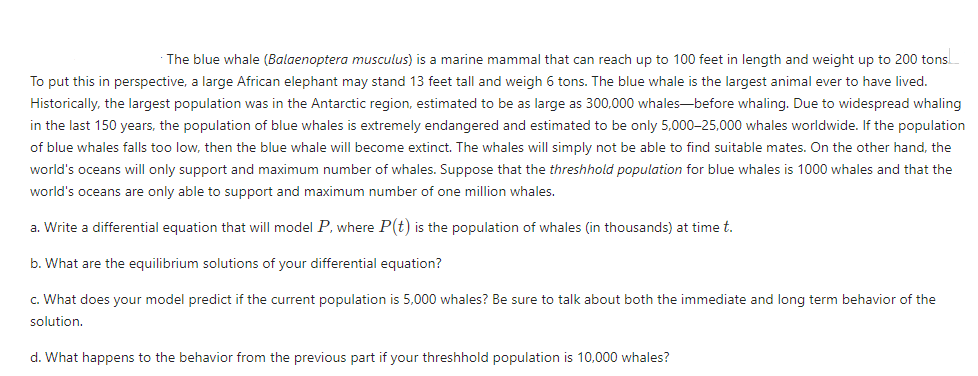Answered step by step
Verified Expert Solution
Question
1 Approved Answer
The blue whale (Balaenoptera musculus) is a marine mammal that can reach up to 100 feet in length and weight up to 200 tons

The blue whale (Balaenoptera musculus) is a marine mammal that can reach up to 100 feet in length and weight up to 200 tons To put this in perspective, a large African elephant may stand 13 feet tall and weigh 6 tons. The blue whale is the largest animal ever to have lived. Historically, the largest population was in the Antarctic region, estimated to be as large as 300,000 whales-before whaling. Due to widespread whaling in the last 150 years, the population of blue whales is extremely endangered and estimated to be only 5,000-25,000 whales worldwide. If the population of blue whales falls too low, then the blue whale will become extinct. The whales will simply not be able to find suitable mates. On the other hand, the world's oceans will only support and maximum number of whales. Suppose that the threshhold population for blue whales is 1000 whales and that the world's oceans are only able to support and maximum number of one million whales. a. Write a differential equation that will model P, where P(t) is the population of whales (in thousands) at time t. b. What are the equilibrium solutions of your differential equation? c. What does your model predict if the current population is 5,000 whales? Be sure to talk about both the immediate and long term behavior of the solution. d. What happens to the behavior from the previous part if your threshhold population is 10,000 whales? The blue whale (Balaenoptera musculus) is a marine mammal that can reach up to 100 feet in length and weight up to 200 tons To put this in perspective, a large African elephant may stand 13 feet tall and weigh 6 tons. The blue whale is the largest animal ever to have lived. Historically, the largest population was in the Antarctic region, estimated to be as large as 300,000 whales-before whaling. Due to widespread whaling in the last 150 years, the population of blue whales is extremely endangered and estimated to be only 5,000-25,000 whales worldwide. If the population of blue whales falls too low, then the blue whale will become extinct. The whales will simply not be able to find suitable mates. On the other hand, the world's oceans will only support and maximum number of whales. Suppose that the threshhold population for blue whales is 1000 whales and that the world's oceans are only able to support and maximum number of one million whales. a. Write a differential equation that will model P, where P(t) is the population of whales (in thousands) at time t. b. What are the equilibrium solutions of your differential equation? c. What does your model predict if the current population is 5,000 whales? Be sure to talk about both the immediate and long term behavior of the solution. d. What happens to the behavior from the previous part if your threshhold population is 10,000 whales?
Step by Step Solution
There are 3 Steps involved in it
Step: 1
a The differential equation that models the population of blue whales over time is dPdt kP1 P1000 wh...
Get Instant Access to Expert-Tailored Solutions
See step-by-step solutions with expert insights and AI powered tools for academic success
Step: 2

Step: 3

Ace Your Homework with AI
Get the answers you need in no time with our AI-driven, step-by-step assistance
Get Started


